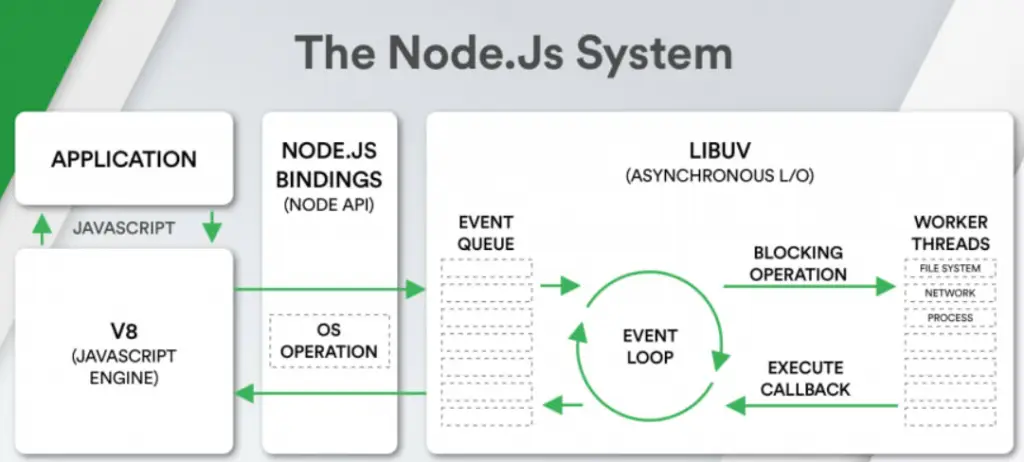The growing domination of web applications in almost all industries has resulted in a radical growth of demand for efficient app development technologies. Business owners can leverage multiple programming languages, technologies, and frameworks to create the web applications they need.
However, for developers looking for the ideal development tools, the diversity of options might be extremely bewildering.
On the other hand, a closer look at Node.js advantages can show you how it is a trusted solution for web app development. JavaScript has served as a cornerstone technology in web development with a continuously expanding area of applications. With the help of Node.js, JavaScript has ventured into the server-side programming aspects of web app development.
The following discussion helps you learn about Node.js, its architecture, and how it works. You can learn about the advantages and disadvantages of Node.js to find out whether it is a reliable choice.
What is Node.Js?

The first thing in any discussion about Node.js disadvantages and advantages for web app development would refer to a definition of Node.js. However, the definition for Node.js is considerably complex as you cannot qualify it as a programming language, a library, or a framework.
On the contrary, the accepted definition of Node.js for web development suggests that it is basically a single-threaded and open-source, cross-platform runtime environment. The primary functionalities of Node.js focus on creating high-performance server-side and networking applications with the assurance of scalability.
Let us reflect a bit on how Node.js turned out as a popular alternative for web development.
You might also like – Popular React Component Library for 2022.
Origins of Node.js
If you ask any developer about the most popular programming language, they would most likely point you towards JavaScript. As a matter of fact, JavaScript is the driving force for millions of websites. JavaScript has tapped into the interests of developers and designers worldwide in building web applications.
However, JavaScript presented a minor setback in the fact that you can use it primarily for client-side scripting. As a result, developers had to use different frameworks and languages for switching between front-end and back-end components in the web development project. Node.js served the ideal solution with a runtime environment, which offered everything needed for executing a JavaScript program.
Popularity of Node.js
The Node.js advantages over JavaScript by enabling front-end and back-end development are obviously a clear reason to choose the language. Does that make Node.js a popular choice for web development? The demand for website development has been growing exponentially in recent times, thereby fuelling the growth of Node.js.
- Interestingly, the popular runtime environment was downloaded over a billion times in 2018.
- According to an estimate by W3Techs, around 1.2% of websites worldwide use Node.js, which may appear quite insignificant. However, it is definitely a big amount when you find that there are more than 20 million websites on the internet today.
- On top of it, many popular companies such as LinkedIn, Twitter, Reddit, eBay, and Spotify use Node.js in their tech stacks.
- The demand for Node.js developers is clearly evident in the fact that they charge around $18 to $36 per hour on Upwork.
Why Do Developers Choose Node.js?
The growing adoption of Node.js on a comparatively larger scale encourages developers, including those specializing in Node.js developers, to seek more information on its architecture and functionality. Before you dive into the reasons for “why use Node.js for backend development,” it is crucial for a Node.js developer to develop a comprehensive understanding of how it works.
Starting with the definition, a Node.js developer can figure out that Node.js is an open-source runtime environment. Moreover, it is imperative to note that it also offers cross-platform compatibility, an essential feature for those focusing on scalability and interoperability as a Node.js developer.
Let us dive deeper into some of the other technical details in the Node.js architecture that every Node.js developer should be familiar with before learning about its working.
1. Architecture of Node.js
Node.js has been written in JavaScript, C, and C++ and runs on a V8 JavaScript runtime engine. One of the notable highlights of Node.js refers to the event-driven, asymmetric I/O architecture, which complements real-time applications effectively.
2. Single-Threaded Event Loop
Another significant highlight in the basic definition of Node.js points toward its single-threaded nature. The ‘Single-Threaded Event Loop’ architecture helps in managing multiple clients at a specific instance.
Multiple clients send requests in a multi-thread request-response model. Now, the server must process each request before sending the relevant response.
At the same time, multiple threads help in processing concurrent calls. A thread pool is used to specify the many threads, and fresh threads are assigned to process new incoming requests.
How Does Node.js Work?

A detailed guide on the possible Node.js disadvantages and its benefits for web development gets better with an understanding of how it works. If you know how Node.js works, you can identify why developers choose it for web development.
The working of Node.js is slightly different than other runtime environments, owing to its single-thread event loop architecture. Here is a step-wise breakdown of the working of Node.js.
- First of all, Node.js focuses on maintaining a limited thread pool for serving requests.
- Node.js places an incoming request in a queue, and the single-thread ‘Event Loop’ component starts working. The primary work of the event loop focuses on indefinitely waiting for requests.
- The loop collects incoming requests from the queue and examines them for blocked I/O requirements. If the request does not need a blocking I/O operation, the loop processes the request, followed by sending a response.
- In the event of a blocking operation, the loop would allocate a thread from the internal pool for processing the requests. The event loop can access limited internal threads, also referred to as the worker group.
- Finally, the loop monitors the blocking requests and puts them in the queue after processing the blocking task. As a result, the loop can maintain a non-blocking nature effectively during its operations.
The use of limited threads in Node.js supports the use of Node.js for web development, as it encourages resource efficiency. At the same time, you can also have the benefit of faster task completion. Therefore, the single-threaded architecture serves as promising support for developing real-time web applications.
Advantages of Node.js
The discussion on Node.js advantages would also require a detailed insight into the features of the runtime environment. Node.js has shown promising growth in recent times, largely due to its features. Here are some of the notable Node.js features that make it a popular choice among developers.
1. Easy to Use
If anyone asks you, “Why use Node.js for backend development,” you can point to the ease of using Node.js. Developers can start using Node.js, especially beginners. Interestingly, you can find many tutorials alongside support from a massive community for getting started on your Node.js journey.
2. Scalability
Another significant highlight in the features of Node.js draws attention to scalability. As a matter of fact, developers choose Node.js largely for the prospects of massive scalability for applications. The single-threaded architecture of Node.js ensures capabilities for managing many simultaneous requests with the assurance of high throughput.
3. Strong Support for Backend Development
Node.js has been written in C and C++, which makes it a suitable choice for backend development. The runtime environment offers faster performance in addition to features such as networking support.
4. Multi-platform Support
The cross-platform support on Node.js serves as a vital tool for developers to work on desktop apps, mobile apps, and SaaS websites. Therefore, the Node.js advantages are not limited to web development projects only.
5. Packages
The next crucial advantage of Node.js refers to the facility of a vast collection of open-source packages. You can find over 1 million packages in the NPM ecosystem for simplifying the development work. Most important of all, Node.js packages also help you manage front-end and back-end development by leveraging JavaScript as a single language.
Setbacks with Node.js
Now that you have a clear idea of the advantages, you must be keen on identifying the setbacks with Node.js. The good news is that you don’t have to worry about many challenges. However, there are some Node.js disadvantages developers must look out for, such as the following.
1. Unstable API
The first entry among setbacks with Node.js emerges from one of the key highlights in Node.js architecture. Many developers have commented on the problems due to the frequent changes in the Node.js API.
The introduction of new changes in the API at frequent intervals can also bring in backward-incompatible changes. Therefore, developers could have to waste their valuable time making changes to accessible code bases. The concern of matching compatibility with the latest Node.js API versions can affect developer productivity.
2. Problems with Heavy Computing
Developers must also look out for Node.js disadvantages like problems in coping with heavy-computing tasks. Node.js allocates all the available CPU strength to tasks in the event loop, thereby slowing down the overall event loop.
3. Asynchronous Programming
The asynchronous programming model in Node.js relies prominently on callbacks. Callbacks work after every task in the queue, thereby offering safeguards for other tasks in the queued background. In some cases, callbacks can directly influence the quality and performance of code.
Therefore, Node.js users may encounter certain limitations in maintaining code, particularly with the burden of tedious and difficult processes.
4. Limited Library Support
The next important highlight among Node.js disadvantages for web app development focuses on the lack of library support. You can find many poor-quality or incomplete NPM registries and libraries without any proper documentation.
Therefore, beginners are more likely to encounter troubles in monitoring faulty libraries and registries. Most important of all, the open-source pool of libraries creates a formidable setback in the form of limited emphasis on coding standards. Subsequently, developers have to struggle with Node.js to implement desired programming tasks.
5. Difficulty in Maintaining Code
The asynchronous programming model in Node.js accounts for another notable setback. You have to encounter the limitations of numerous callbacks due to the asynchronous nature of Node.js.
The callback function operates immediately following the tasks in the queue while safeguarding many other tasks in the queue. In the event of many complex callback requests, developers would encounter difficulties in maintaining code.
What Are the Use Cases for Implementing Node.js?
The overview of Node.js advantages and setbacks offers a balanced impression of its capabilities. You must have some doubts about employing Node.js in a real web development project. However, you might find the solution to your doubts with an outline of some of the top Node.js use cases.
- Node.js can serve as vital support for managing multiple concurrent requests alongside asynchronous processing in IoT applications.
- Node JS Developers can implement push notifications and server-side events for instant messaging by using the WebSocket compatibility and Event API.
- Node.js also serves as a vital asset in applications involving microservice architecture by supporting the linking between numerous servers. The streamlined procedure enables seamless collaboration between developer teams without any massive changes in the whole program.
- Another top application of Node.js that outshines the Node.js disadvantages refers to real-time collaboration tools. Node.js offers the value of resiliency on the grounds of capabilities for managing many I/O operations with multiple users without slowing down the servers.
As a result, Node.js is a great choice for developing social networking sites.
- The most prominent example of a Node.js application is Netflix, as it is ideal for streaming purposes. Node.js is light, fast, and efficient alongside offering a native streaming API.
The streams in the API help users in piping requests to each other, thereby enabling direct data streaming to the final destination.
- Developers also find Node.js advantages helpful in developing complex single-page applications or SPAs. The complete application is available on a single page in SPAs, thereby implying certain requests in the background for particular components.
The event loop in Node.js helps in processing requests without the non-blocking approach, thereby ensuring reliable data transfer.
Conclusion
The widespread adoption of Node.js speaks a lot about its popularity. Many notable companies such as Reddit, LinkedIn, Netflix, and Spotify use Node.js.
The open-source runtime environment evolved as an answer to the limitations of JavaScript in server-side development. Node.js resolved the issue with an easy-to-use runtime environment featuring an assortment of benefits for developers.
At the same time, Node.js also presents certain setbacks for developers due to the asynchronous model or problems in dealing with heavy-duty computing tasks. Developers must learn about the best practices for using Node.js in web development with a balanced impression of its capabilities.
As of now, Node.js is a powerful choice for developing scalable, high-performance online applications.







